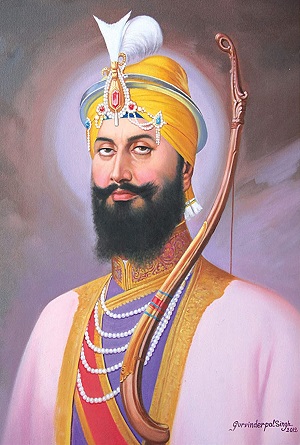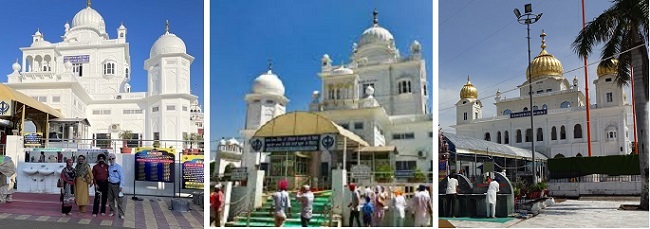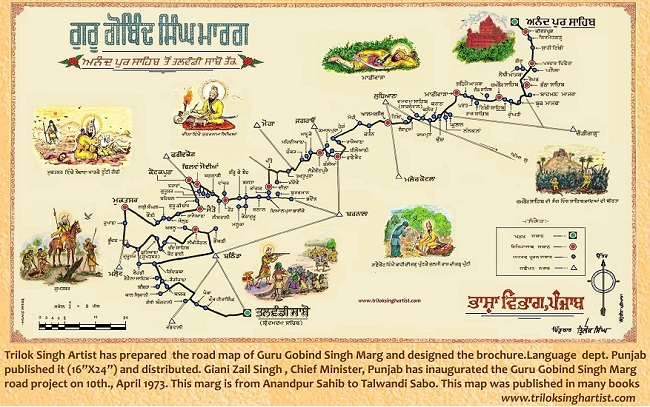Nov 25, 2025
Nov 25, 2025
Continued from Previous Page
 On March 29, 1699, Guru Ji held a great Vaisakhi gathering in Kesgarh Sahib in Anandpur. Guru Ji had sent out invitations to all the Sikh sangat to come out there for momentous event. The estimate by the royal spies puts the number of attendees to 80,000. At the conclusion of singing of Asa-De-Var, Guru Ji stepped to the podium with an unsheathed Kirpan in his hand and asked for a head. Bhai Daya Ram stepped forward to offer his head. Guru Ji took him to a separate tent and came back with the blood-soaked Kirpan and asked for another head. This was repeated additionally three more times. After the offering of heads by these five, Guru Ji had stayed in the tent for longer time. Finally, Guru Ji came out of the tent, his Kirpan was sheathed, and his face radiated joy and satisfaction. He was followed by these five, all dressed in new clothes like Guru Ji’s. Then next day being Vaisakhi, Guru Ji held the Khande-De-Pahul initiation to these five, asked them to adopt Singh as the last name, and presented them before the gathering. He called them his beloved by naming them ‘Panj Pyaras’. Next what he did was unheard of in the annals of history, which was to ask those five to bless him with the Khande-De-Pahul. Guru Ji too adopted Singh as his second name instead of Rai. With one masterly stroke Guru Ji had ended caste-based discrimination, as well as the gap between master and disciple. Bhai Gurdas Singh has penned these words to describe this revolutionary act as:
On March 29, 1699, Guru Ji held a great Vaisakhi gathering in Kesgarh Sahib in Anandpur. Guru Ji had sent out invitations to all the Sikh sangat to come out there for momentous event. The estimate by the royal spies puts the number of attendees to 80,000. At the conclusion of singing of Asa-De-Var, Guru Ji stepped to the podium with an unsheathed Kirpan in his hand and asked for a head. Bhai Daya Ram stepped forward to offer his head. Guru Ji took him to a separate tent and came back with the blood-soaked Kirpan and asked for another head. This was repeated additionally three more times. After the offering of heads by these five, Guru Ji had stayed in the tent for longer time. Finally, Guru Ji came out of the tent, his Kirpan was sheathed, and his face radiated joy and satisfaction. He was followed by these five, all dressed in new clothes like Guru Ji’s. Then next day being Vaisakhi, Guru Ji held the Khande-De-Pahul initiation to these five, asked them to adopt Singh as the last name, and presented them before the gathering. He called them his beloved by naming them ‘Panj Pyaras’. Next what he did was unheard of in the annals of history, which was to ask those five to bless him with the Khande-De-Pahul. Guru Ji too adopted Singh as his second name instead of Rai. With one masterly stroke Guru Ji had ended caste-based discrimination, as well as the gap between master and disciple. Bhai Gurdas Singh has penned these words to describe this revolutionary act as:
![]()
“Waho Waho Gobind Singh ape Guru Chela.” – (Amrit Keertan, Pg. No. 281)
Translation: Hail, hail (Guru) Gobind Singh; He, Himself, is the Master and Disciple too.
In the meantime the Hill-Chiefs alarmed at growing power and influence of Guru Ji decided to curtail it by sending a message to Guru Ji to either pay rent for Anandpur or vacate it, which Guru JI refused. The attacks on Anandpur by Hill-chiefs were successively repulsed. In 1700 to force Guru Ji to leave Anandpur two Hill-Chiefs ambushed Guru Ji’s hunting party returning back after expedition. Caught unawares the Sikhs fought valiantly and successfully beat the ambush. One Hill-chief was killed, and the right arm of the other chief was chopped off. The outcome made the Hill-Chiefs feel insecure, so they formed an alliance of Hill-Chiefs, to curtail the growing power of Guru Ji. At their conclave the Hill-Chiefs decided to enlist the aid of Imperial army through a petition to Governor of Sirhind, Wazir Khan. Governor obtained the emperor’s sanction and dispatched a contingent of 10,000 under command of Dina Beg and Painda Khan. The combined forces of the Hill-Chiefs and the Governor totaling over 20,000 approached Anandpur. Guru Ji had a force of 7,000 and a bloody battle ensued. Guru Ji’s eldest son Baba Ajit Singh 14 also participated in his maiden battle and showed his mettle. With the battle tilting in favor of Guru Ji, Painde Khan stepped forward and asked Guru Ji for one-to-one combat. Painde Khan shot 2 arrows at Guru Ji but missed his mark. After missing his aim, he was quickly retreating, when Guru Ji asked him to stop as it was Guru Ji’s turn. Painde Khan’s body was fully covered with body armor except for his ears. So, Guru Ji took aim at his ear with an arrow, hitting the target felling him to the ground. The panicked joint armies made a hasty retreat.
On May 03, 1704, the armies of Hill-Chiefs along with forces of Faujdars of Sirhind and Lahore re-attacked Anandpur Sahib. There initial attack was met with a strong resistance, so they opted for a siege instead of engaging in a frontal assault to avoid casualties on their side. The siege lasted over seven months with all incoming and outgoing supplies cut-off, putting the Sikhs in a very dire straits as arms, ammunition, food, and water supplies were running extremely low. The hunger and starvation coupled with assurances of safe passage sounded appealing to some Sikhs, while Guru Ji saw it as a trap. Still forty Sikhs pressed Guru Ji again to accept the safe passage offer. Guru Ji asked them to write a letter to him disowning their Guru if they desired to leave. Which they complied with and left. The Mughal army gave them a free pass in anticipation of more defections. However, the remaining inside Anandgarh fort opted to endure despite the worsening situation. With deaths and desertions only 500 plus five pyaras from the beginning number of 7000 remained in the fort. Then the enemy delivered a letter from Emperor Aurangzeb containing assurances of safe passage. The Sikhs held a conclave and decided it was need of the time to evacuate. They presented their viewpoint as Panj Pyare, which was reluctantly acceded to by Guru Ji. The preparation for evacuation started immediately.
They evacuated the fort at the dead night on 20 December 1704, while it was raining heavily and Sarsa stream was swollen with the rainwater. The heavy downpour with chilly winds blowing on a bitterly cold winter night made the evacuation challenging. Mata Gujri and Chotte Sahibzadaes got separated from the rest of contingent, landing in Kheri village next morning. Guru Ji had left behind Bhai Sant Singh and Bhai Sangat Singh primarily to give the impression that the fort was not evacuated. Early next morning the Mughal forces discovered that the fort had been evacuated so the search parties fanned out. They caught the fringe of the Sikhs crossing Sarsa and a fierce fighting ensued there. Guru Ji along with advance party had already crossed Sarsa. The Mughal forces chased the Sikhs, but still Guru Ji decided to have Asa De Vaar kirtan on the other side of Sarsa after crossing it. From there they went to Keeratpur and Nirmohgarh but were directed to go to Kotla Nihang in Ropar. That was just a brick kiln in an open field, instead Guru Ji went to Chamkaur on December 21, 1704. By nightfall the chasing Mughal forces reached there and surrounded the entire village.
Next morning the arrows started flying towards the mud Haveli occupied by the Guru and his Sikhs. The first attempt of the royal forces to break the door open was successfully repulsed. The forces regrouped and made another attempt with additional reinforcements, which failed again. Next General Nahar Khan had ladders installed and he himself started climbing to make a surprise assault. As soon he lifted his head upwards, he became victim of Guru Ji’s arrow falling flat on the ground. Gani Khan took over the lead started climbing the ladder, when Guru Ji dropped a mast on his head killing him. The spectacle made General Mehmood Ali run for his own safety, which demoralized their forces. Even the two elder sons of Guru Gobind Singh died fighting bravely in the battle displaying exemplary courage.
By nightfall the fighting seized, the remaining five Sikhs pleaded with Guru Ji to evacuate. Guru Ji acceded to their call and decided to take Bhai Daya Singh, Bhai Dharam Singh, and Bhai Man Singh with him. Sangat Singh was dressed in Guru Ji’s clothes, complete with plume along with Sant Singh as his companion were to remain there giving them impression of Haveli still being occupied. The fate of these two remaining there was obvious to become martyrs. Bhai Sangat Singh’s head was cutoff to be sent to Delhi as a proof that Guru Ji had been killed. It was only later did they realize their folly and that Guru Ji has escaped. In the pitch darkness Guru Ji got separated from his three accompanying Sikhs landing alone in Machiwara forest. Exhausted, hungry, in wet clothes, Guru Ji finally got some sleep, but had his unsheathed kirpan in his hand for his own protection.
The three separated Sikhs were reunited with Guru Ji in Machiwara when they found Guru Ji sleeping. From there with the help of Nabi Khan and Gani Khan, dressed as “Uch Da Pir” Guru Ji left for Jatpura. Guru Ji sent Mahi to find out about the Chotte Sahibzades and Mata Gujri Ji. It was here only he got the news that these two young souls chose death by being bricked alive, refusing entreaties from the Nawab Wazir Khan of Sirhind. When Nawab got wind of Guru Ji’s efforts to raise new forces, he dispatched forces. The Nawab’s forces came face to face with Sikhs at Khidrana (now called Muktsar) in January 1705. This was where the earlier 40 deserters from Anandpur had rejoined Guru Ji and being at the rear of convoy fought with Wazir’s forces with strongest determination and faith. Their fate of being wiped out was clear, but their strong resistance provided the Guru Ji and Sikhs leading the move to gain some breathing space and time to get out of the harm’s way.

Gurdwara Chamkaur Sahib Gurdwara Fatehgarh Sahib Gurdwara Thanda Burj
Before moving further, let us recap the fate of the Chotte Sahibzades and Mata Gujri Ji. They had spent the first night in Kamoh Masakhi’s hut. Next morning Gangu, who was earlier employed in Guru Ji’s kitchen approached them and invited them to stay with him in his village Kheri. At night while all three were sleeping, Gangu helped himself with the money and jewelry. When in the morning Mata Ji confronted him, raising hue and cry he went straight to Kotwal in Morinda to report about their whereabouts. They were arrested from Gangu’s house and spent the night in the Kotwali. Next day they were moved to Sirhind and presented to Nawab Wazir Khan in his court. Nawab offered them inducements of comfortable life and marriages into royal families if they embraced Islam. But the two Sahibzades were firm in their faith. They were given a night to think about the offer but when they did not relent, they were told that the price for defiance was death. They were bricked alive on 27 December 1704. This was the week where the history of a century unfolded in quick succession. When Mata Gujri, the paternal grandmother was given the news of the martyrdom she said; “They have gone to their grandfather in the lap of God.” Further saying; “She had taken the duty of looking after them, and now they are gone, my soul fly after them to their Divine Abode.” Saying that she breathed her last.
The route taken by Guru Ji after evacuation from Anandpur has been made it a highway named Guru Gobind Singh Marg. A map of the highway is as below.

Continued to Next Page
28-Jan-2023
More by : Bhupinder Singh